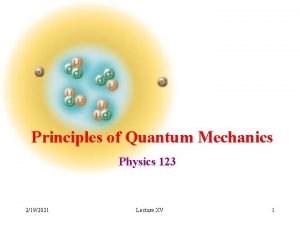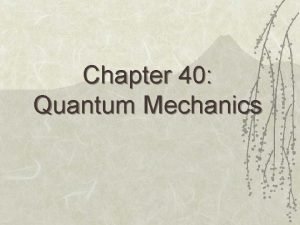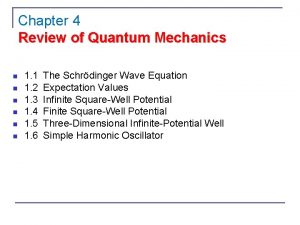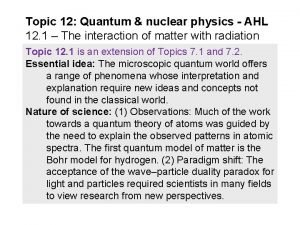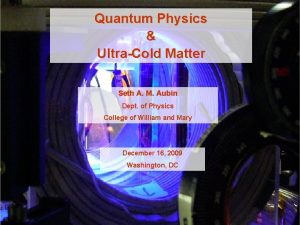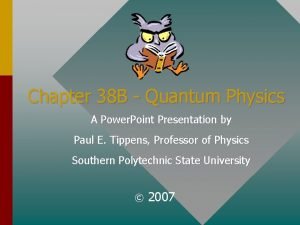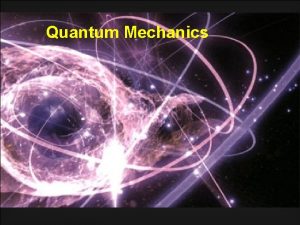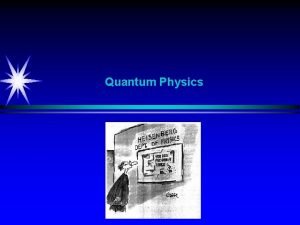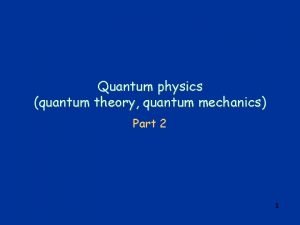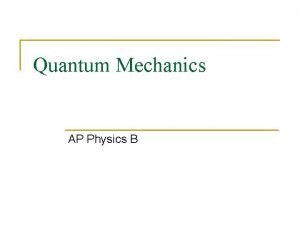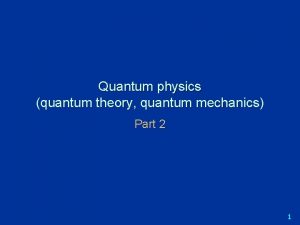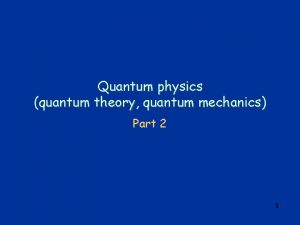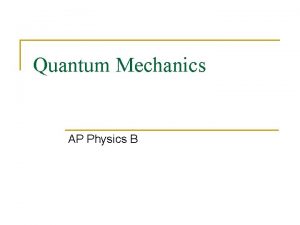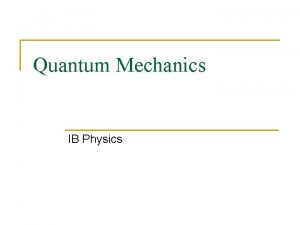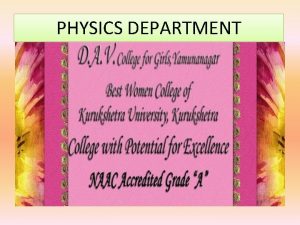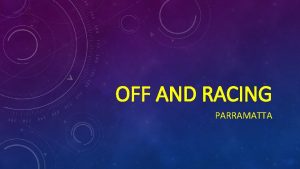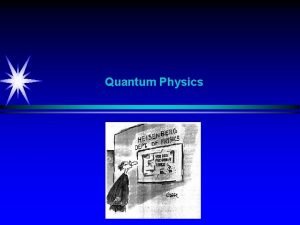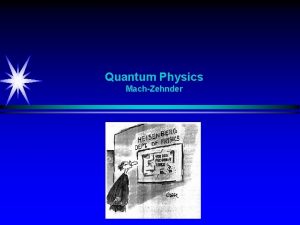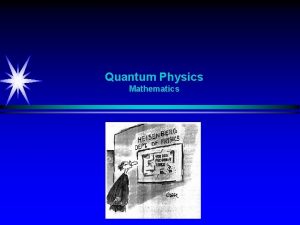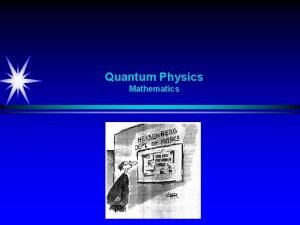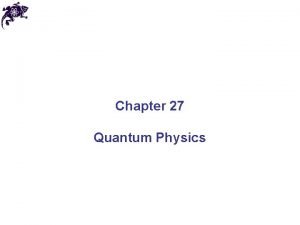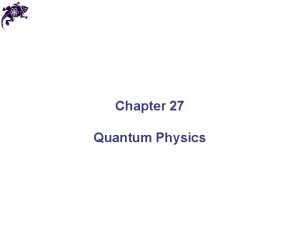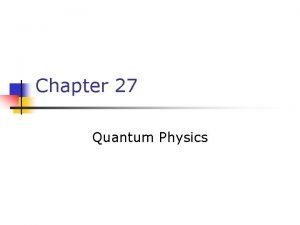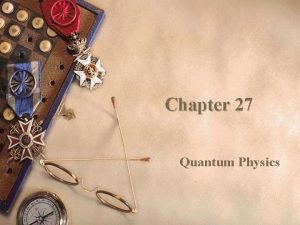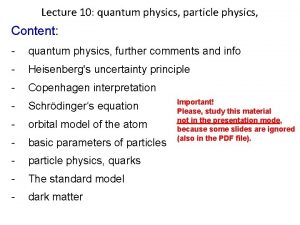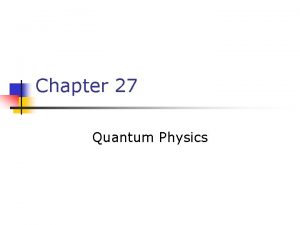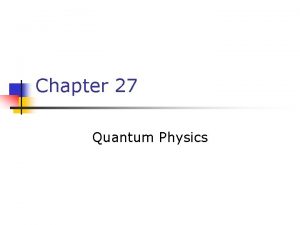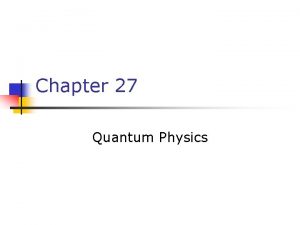Quantum Racing 42 and The Physics of Racing


































- Slides: 34

Quantum Racing 42 and The Physics of Racing Bowling Green State University [ [ Department of Physics and Astronomy BGSU Society of Physics Students

Outline • Grand Prix of BGSU • Quantum Racing – Why? – 2005 Team – Kart • Construction • Testing • Race Day • Physics of Racing – – – Center of Mass/Weight Shift Tires Steering Corners Engine Gears

Grand Prix of BGSU • Kart race – Bring motorsports to BGSU Campus – Promote clean Energy (E 85)

Why should SPS go racing? • Real life application of Physics – Hands on experience – Brings the physics to life HAVE FUN WITH PHYSICS!!

Quantum Racing Team Crew Chief Matt Hodek Driver Jen Bradley Crew Members Ryan Henderson Billy Schmidt Scorer Ryan Loreck Track Worker Ian Nemitz

Kart Construction Purchased a base racing chassis

Kart Construction Build a safety cage

Kart Construction Engine and Clutch

Kart Testing • Several Driver training and kart testing sessions. – Improve driver skill and familiarity with kart – Adjust kart to provide best kart for the driver.

Data Acquisition • Alfano – Records: RPM Head Temp Wheel Speed G-force Lap times – 10 hz ~90 min – 24 -40 hrs (lap only)




The Physics of Racing An Introduction

How the kart moves What makes it move

COM and Weight Shift • COM (Center of Mass) – Very important • Where it is • How to change it • Weight Shift De-accelerating Accelerating – Effects handling of car • (de)acceleration • Cornering Grip

Tires! brake • FRICTION!! • Traction Circle – Limited traction available • Slip Angle • Relies heavily on weight transfer right left Accel Right Front Tire

Steering Turn Caster forward lower Raise COM Shift Kingpin Inclination Lifted off the ground Scrub Radius

Steering

Steering Turn Ackerman Steering Raise Lifted off the ground lower

Chassis setup and Tires • Determines how the weight is transferred to each wheel under different conditions More grip: Decrease tire pressure Stiffen Chassis sections Move weight towards wheel Understeer Less grip: Increase tire pressure Flexable Chassis sections Move weight away from wheel Oversteer Front Grip Rear Grip

Corners Goals: • widest arc possible • Keep speed up • Retain as much momentum as possible Outside - worst Inside - better Apex - Best

Corners

How the kart moves What makes it move

Engine • Thermodynamics –Compression –Combustion • Fluid Mechanics – Air flow – Volumetric efficiency • Mechanical Engineering – Converting combustion Into mechanical force

Gears Higher Ratio more torque less top end speed Lower Ratio less torque more top end speed 32 teeth 16 teeth 2: 1 gear ratio

On going Studies The Advanced Physics of Racing

Topics of Study • Thermodynamic model of the engine • • Air cycle Fuel-air cycle Air capacity Ambient conditions • Dynamical model of the Chassis • Chassis flex • Harmonic Oscillation

Measured Hp/torque curves • Comparison to Experimental data • Smoothing Data • Clutch issue

Simple Air Cycle Model • Assumptions – Air is an ideal gas, fuel is not part of the charge – Each cycle draws full charge regardless of rpm – The combustion is complete



Fuel-Air Cycle • “An idealized process using as its working medium real gasses that closely resembling those used in the corresponding engine. “ • Not a ‘thermodynamic cycle’ • Assumptions – No chemical change before or after combustion – After combustion, the charge is in chemical equilibrium – All processes are adiabatic – Velocities of the charge are negligable

Thank You Quantum Racing 42 Any Questions? Sources Taylor, Charles F. The Internal-Combustion Engine in Theory and Practice. 2 nd ed. Vol. 1. Cambridge, Massachusetts: The M. I. T. P, 1985. Beckman, Brian. "The Physics of Racing. " SCCA Cal. Club Newsletter.
 Classical mechanics
Classical mechanics Quantum physics vs quantum mechanics
Quantum physics vs quantum mechanics Physics topic 12
Physics topic 12 Quantum physics wave function
Quantum physics wave function Khan academy
Khan academy Ap quantum physics
Ap quantum physics Quantum physics wave function
Quantum physics wave function Quantum physics wave function
Quantum physics wave function Quantum nuclear physics
Quantum nuclear physics Seth aubin
Seth aubin Electron volt to volt
Electron volt to volt Quantum physics in hindi
Quantum physics in hindi Sled dog racing and the 5 themes of geography
Sled dog racing and the 5 themes of geography Modern physics vs classical physics
Modern physics vs classical physics University physics with modern physics fifteenth edition
University physics with modern physics fifteenth edition Ib physics ia ideas mechanics
Ib physics ia ideas mechanics Hát kết hợp bộ gõ cơ thể
Hát kết hợp bộ gõ cơ thể Ng-html
Ng-html Bổ thể
Bổ thể Tỉ lệ cơ thể trẻ em
Tỉ lệ cơ thể trẻ em Gấu đi như thế nào
Gấu đi như thế nào Tư thế worms-breton
Tư thế worms-breton Chúa yêu trần thế alleluia
Chúa yêu trần thế alleluia Các môn thể thao bắt đầu bằng tiếng nhảy
Các môn thể thao bắt đầu bằng tiếng nhảy Thế nào là hệ số cao nhất
Thế nào là hệ số cao nhất Các châu lục và đại dương trên thế giới
Các châu lục và đại dương trên thế giới Công thức tính thế năng
Công thức tính thế năng Trời xanh đây là của chúng ta thể thơ
Trời xanh đây là của chúng ta thể thơ Mật thư tọa độ 5x5
Mật thư tọa độ 5x5 101012 bằng
101012 bằng độ dài liên kết
độ dài liên kết Các châu lục và đại dương trên thế giới
Các châu lục và đại dương trên thế giới Thơ thất ngôn tứ tuyệt đường luật
Thơ thất ngôn tứ tuyệt đường luật Quá trình desamine hóa có thể tạo ra
Quá trình desamine hóa có thể tạo ra Một số thể thơ truyền thống
Một số thể thơ truyền thống



